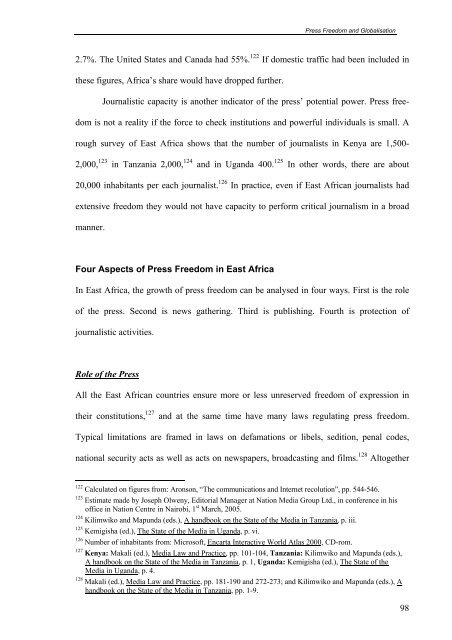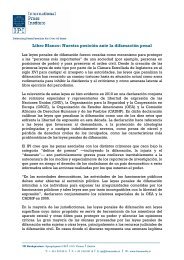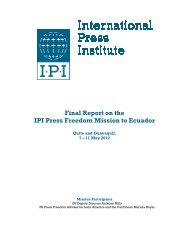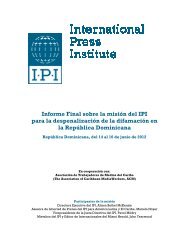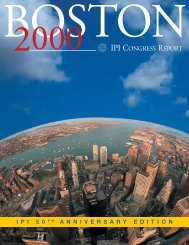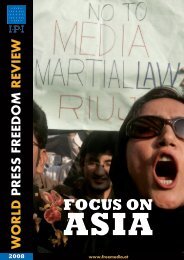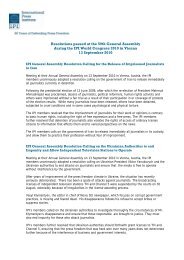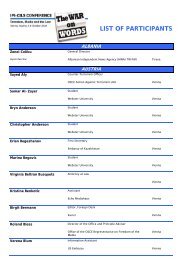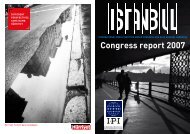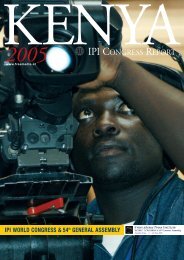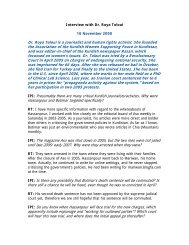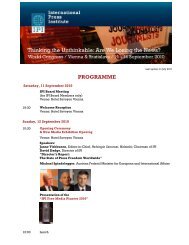Press Freedom and Globalisation - International Press Institute
Press Freedom and Globalisation - International Press Institute
Press Freedom and Globalisation - International Press Institute
Create successful ePaper yourself
Turn your PDF publications into a flip-book with our unique Google optimized e-Paper software.
<strong>Press</strong> <strong>Freedom</strong> <strong>and</strong> <strong>Globalisation</strong><br />
2.7%. The United States <strong>and</strong> Canada had 55%. 122 If domestic traffic had been included in<br />
these figures, Africa’s share would have dropped further.<br />
Journalistic capacity is another indicator of the press’ potential power. <strong>Press</strong> free-<br />
dom is not a reality if the force to check institutions <strong>and</strong> powerful individuals is small. A<br />
rough survey of East Africa shows that the number of journalists in Kenya are 1,500-<br />
2,000, 123 in Tanzania 2,000, 124 <strong>and</strong> in Ug<strong>and</strong>a 400. 125 In other words, there are about<br />
20,000 inhabitants per each journalist. 126 In practice, even if East African journalists had<br />
extensive freedom they would not have capacity to perform critical journalism in a broad<br />
manner.<br />
Four Aspects of <strong>Press</strong> <strong>Freedom</strong> in East Africa<br />
In East Africa, the growth of press freedom can be analysed in four ways. First is the role<br />
of the press. Second is news gathering. Third is publishing. Fourth is protection of<br />
journalistic activities.<br />
Role of the <strong>Press</strong><br />
All the East African countries ensure more or less unreserved freedom of expression in<br />
their constitutions, 127 <strong>and</strong> at the same time have many laws regulating press freedom.<br />
Typical limitations are framed in laws on defamations or libels, sedition, penal codes,<br />
national security acts as well as acts on newspapers, broadcasting <strong>and</strong> films. 128 Altogether<br />
122<br />
Calculated on figures from: Aronson, “The communications <strong>and</strong> Internet recolution”, pp. 544-546.<br />
123<br />
Estimate made by Joseph Olweny, Editorial Manager at Nation Media Group Ltd., in conference in his<br />
office in Nation Centre in Nairobi, 1 st March, 2005.<br />
124<br />
Kilimwiko <strong>and</strong> Mapunda (eds.), A h<strong>and</strong>book on the State of the Media in Tanzania, p. iii.<br />
125<br />
Kemigisha (ed.), The State of the Media in Ug<strong>and</strong>a, p. vi.<br />
126<br />
Number of inhabitants from: Microsoft, Encarta Interactive World Atlas 2000, CD-rom.<br />
127<br />
Kenya: Makali (ed.), Media Law <strong>and</strong> Practice, pp. 101-104, Tanzania: Kilimwiko <strong>and</strong> Mapunda (eds.),<br />
A h<strong>and</strong>book on the State of the Media in Tanzania, p. 1, Ug<strong>and</strong>a: Kemigisha (ed.), The State of the<br />
Media in Ug<strong>and</strong>a, p. 4.<br />
128<br />
Makali (ed.), Media Law <strong>and</strong> Practice, pp. 181-190 <strong>and</strong> 272-273; <strong>and</strong> Kilimwiko <strong>and</strong> Mapunda (eds.), A<br />
h<strong>and</strong>book on the State of the Media in Tanzania, pp. 1-9.<br />
98


